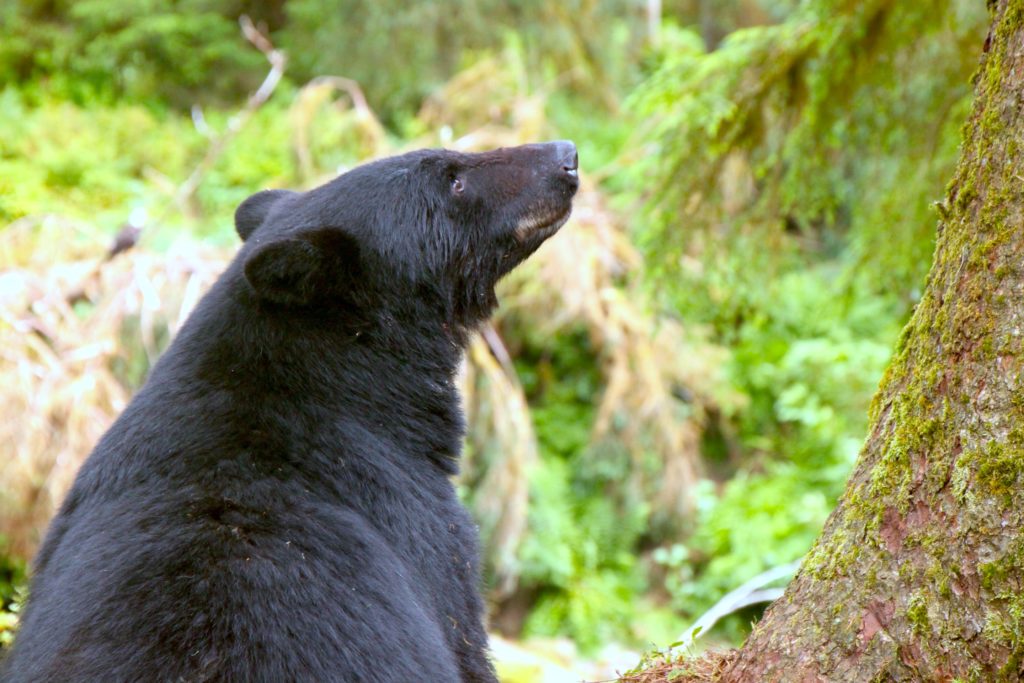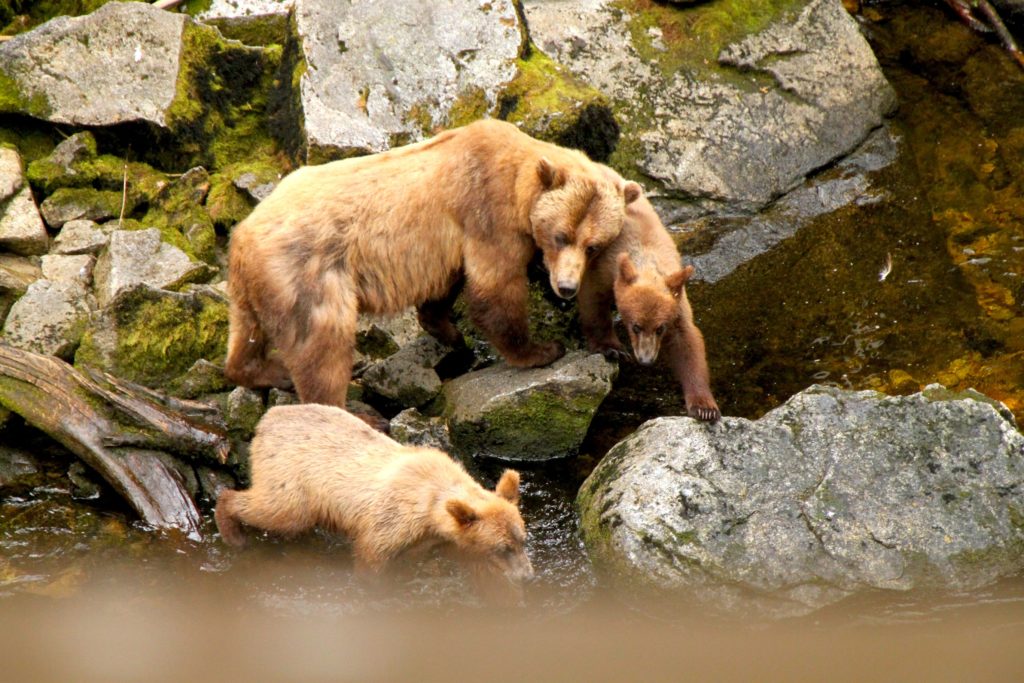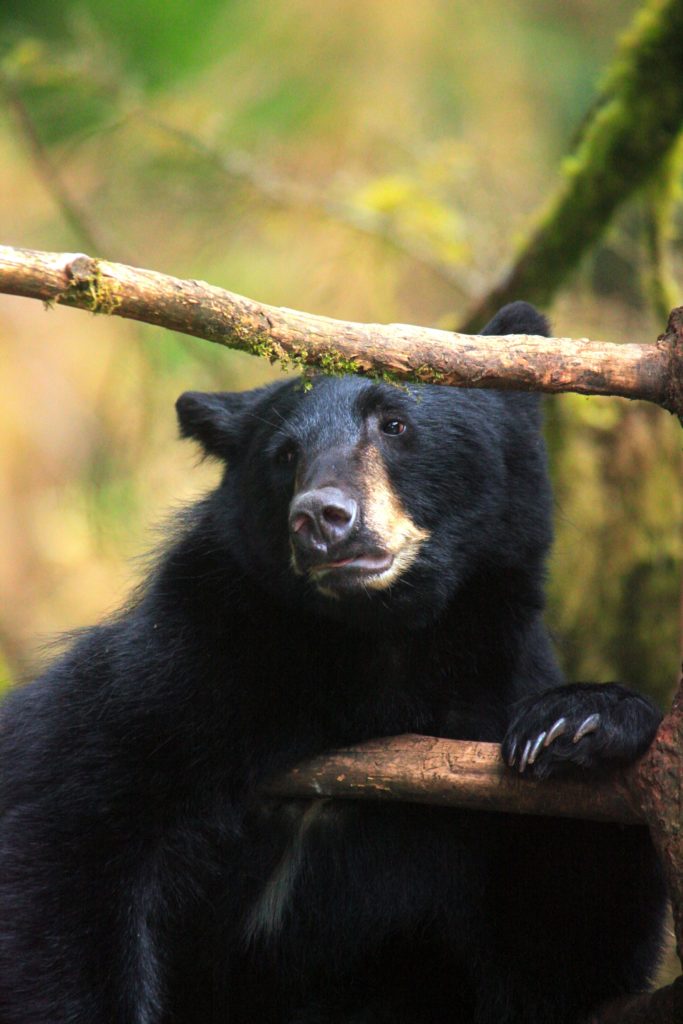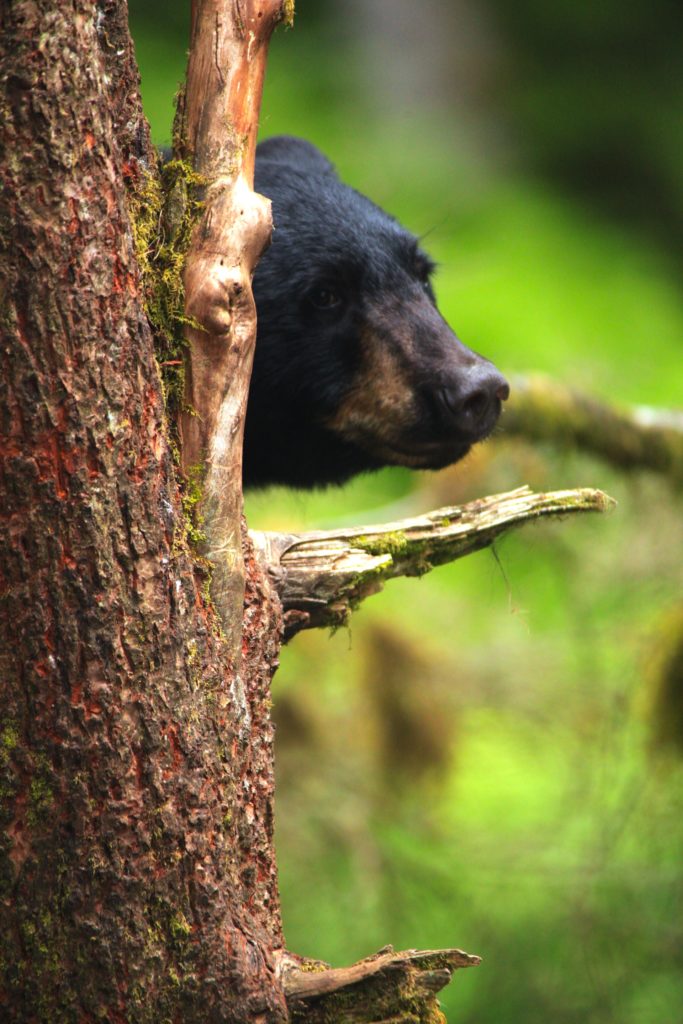
Black bears abound on Prince of Wales Island, emerging from their winter slumber in search of skunk cabbage and fawns. Early in the season, we’ll spot them crossing roads and trails, foraging through the forests and meandering along the shorelines munching grass and sticking their snouts in every curiosity. As the salmon start to swim up the streams, their location is more predictable: sitting fat and happy in crystal clear pools munching on salmon. Silver and pink salmon runs near the lodge provide a daylong buffet for these up to 350 pound beasts. Soon enough they’ll turn their attentions to the dessert course and run their paws through the berry bushes to delight in an endless crop of summer succulence.
 Brown bears, close cousins to the Kodiak and grizzly bears, are also prevalent in our area. By late June, they can be regularly found at fish creeks along the mainland shores. The vegetation and fish rich environment of Southeast Alaska as well as the milder climate allows our brown bears to grow larger and live in higher densities than their “grizzly” cousins in the northern and interior parts of the state. You may choose to visit areas known for the rare chance to see both brown and black bears and their cubs sharing the same creek as they feast on a massive, months-long run of salmon. Day-long, boat and land based brown bear excursions are an adventure menu option at The Lodge at Whale Pass, or you can charter a floatplane for an air safari and land along the shorelines upon spotting these magnificent creatures. (Floatplane charters require extra charge).
Brown bears, close cousins to the Kodiak and grizzly bears, are also prevalent in our area. By late June, they can be regularly found at fish creeks along the mainland shores. The vegetation and fish rich environment of Southeast Alaska as well as the milder climate allows our brown bears to grow larger and live in higher densities than their “grizzly” cousins in the northern and interior parts of the state. You may choose to visit areas known for the rare chance to see both brown and black bears and their cubs sharing the same creek as they feast on a massive, months-long run of salmon. Day-long, boat and land based brown bear excursions are an adventure menu option at The Lodge at Whale Pass, or you can charter a floatplane for an air safari and land along the shorelines upon spotting these magnificent creatures. (Floatplane charters require extra charge).
Brown and grizzly bears are classified as the same species even though there are notable differences between them. Those that typically live along the coastal areas of the state are typically referred to as browns. These areas have access to seasonally abundant spawning salmon and a rich array of vegetation they can use as food as well as a milder climate. This allows them to grow larger and live in higher densities than their “grizzly” cousins in the northern and interior parts of the state.
 Black bears on Prince of Wales average are usually under three feet from ground to shoulder, and around five feet from nose to tail. They’ll weigh under two hundred pounds when they emerge from their winter rest and can get as big as three hundred pounds by the end of the season. Brown bears, on the other hand, have a shoulder height of around four to four and one-half feet and a body length of eight feet. They average between eight hundred and 1,200 pounds.
Black bears on Prince of Wales average are usually under three feet from ground to shoulder, and around five feet from nose to tail. They’ll weigh under two hundred pounds when they emerge from their winter rest and can get as big as three hundred pounds by the end of the season. Brown bears, on the other hand, have a shoulder height of around four to four and one-half feet and a body length of eight feet. They average between eight hundred and 1,200 pounds.
While black bears are most often black in color, they often have a brown muzzle, though cinnamon-brown, reddish, grey and even bluish colorations are not unheard of. A better method of differentiating the species is by body shape. Black bears exhibit a straight facial profile and their short claws rarely grow more than one and one-half inches in length. Black bears have adequate sense of sight and hearing but have an outstanding sense of smell. Brown bears are usually larger than black bears, have a more prominent shoulder hump, less prominent ears, and longer, straighter claws. The varying shapes are adaptations to their particular life styles. Long claws are useful in digging roots or excavating small mammals but are not efficient for climbing trees. The musculature and bone structure of the hump are adaptations for digging and for attaining bursts of speed necessary for the capture of larger prey.
 Our guides strive to put you mere feet from feeding bears in relative safety and comfort. You’ll have no problem filling up your flashcards and memory banks with endless images of bears to rival those in National Geographic Magazine. And, don’t think that bear viewing will be limited to planned excursions as you just might share the day with them wherever you wander on the water or the island.
Our guides strive to put you mere feet from feeding bears in relative safety and comfort. You’ll have no problem filling up your flashcards and memory banks with endless images of bears to rival those in National Geographic Magazine. And, don’t think that bear viewing will be limited to planned excursions as you just might share the day with them wherever you wander on the water or the island.
Whales & Marine Life
Opportunity to tell user what they will find here.

